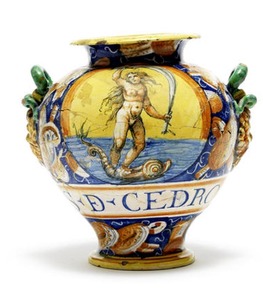ART AUCTION
Two Rhineland Stoneware Bellarmines, first half 17th century are two of the Fine European Ceramics on auction. Estimate: $ 1,000 – 1,400. Image courtesy of Bonhams
ART AUCTION
Fine European Ceramics and historically important works set for auction

A Castel Durante Maiolica Apothecary Jar, circa 1580. Important example of Fine European Ceramics. Estimate: $3,400 – 5,100. Image courtesy of Bonhams
LONDON— Bonhams Fine European Ceramics Auction on June 18, 2014, will include a host of Fine European Ceramics and historically important works. The auction includes items from an important private collection of decorative arts from the Emma Budge Collection. Items from the Emma Budge collection are among the most notable lots in the sale and have a dark and fascinating story to tell. The auction is slated for New Bond Street,
Emma and Henry Budge had returned to Germany in 1903 after Henry had made his fortune financing American railroads. They built a magnificent villa in Hamburg, along the grand Harvestehuder Weg, which they extended to included a Versaille style Hall of Mirrors. It became the venue of many philanthropic charity balls and became the centre of the city’s cultural and social life and Emma Budge filled their home with fine antiques. The Budge’s were advised by the Hamburg Museum’s legendary curator, Justus Brinckmann, and by the First World War, Emma had amassed one of the most important decorative arts collections in Germany.
Painful History of the Emma and Henry Budge Fine European Ceramics Collection
When Henry died in 1928, Emma Budge had no children and had intended to leave her collection to the city of Hamburg – the city of her birth but changed her mind when the Nazi’s came to power. Being from a Jewish family, her collection and estate was forcibly sold by the state and her heirs received none of the proceeds.
In an effort to reclaim their heritage, lawyers of the Budge heirs have successfully persuaded museums to return objects to the family. Bonhams now offers for sale a collection of five pieces from the collection on behalf of the Budge heirs. The most valuable of these is a very rare pair of Höchst figures of Pantaloone and Pantalone from the Italian Comedy, circa 1752 which are estimated at £30,000-40,000. A rare Höchst figure (circa 1752) of La Scaramouche also from the Italian Comedy, is estimated to sell for £15,000-20,000.
Another extremely valuable item in the sale is exceptional piece of Vezzi porcelain superbly painted with a scene showing Venus and Adonis embracing dates from circa 1725. The vase is estimated to sell for £70,000-100,000. Only a handful of large Vezzi vases are recorded and this vase is one of the largest pieces of Vezzi porcelain known. The Vezzi factory was only in operation for a short period of time, and all surviving pieces are regarded as absolute rarities.
A very rare and large maiolica plaque, dating from 1541 and painted in the workshop of Baldessare Manarais estimated to sell for £80,000-100,000. The painted scene is based on a print after Raphael’s depiction of The Way to Calvary (now in the Prado Museum, Madrid).
Another survivor of the World War II is a Meissen large oval tray from the famous Swan Service, circa 1740. This is one of the most important examples of fine European ceramics. It is modelled by J.F. Eberlein and estimated at £30,000-50,000. The dish is moulded with swans swimming amidst bulrushes and holds a gilt-edged border painted with the arms of Brühl and Kolowrat-Krakowska. The Swan Service was made in 1737-43, and it eventually numbered more than 2,200 pieces. The Swan Service of Meissen porcelain was almost destroyed at the end of the Second World War. At the end of World War II, the remaining pieces of the Swan Service were scattered amongst collectors and museums.
